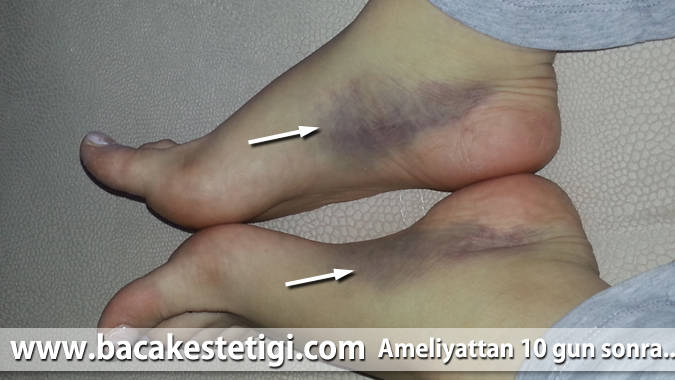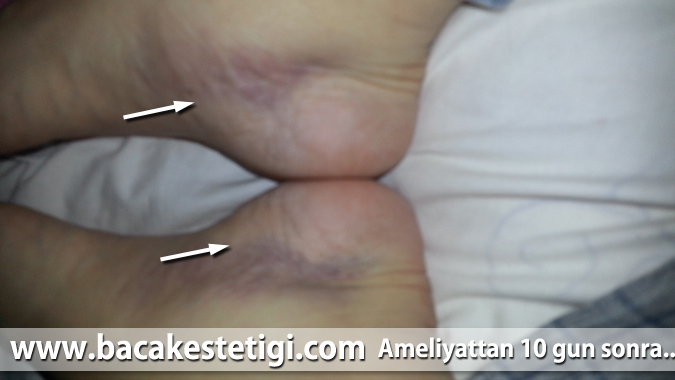
 Please click here for telephone consultation and appointment. You will be directed to Dr. Oytun İdil.
Please click here for telephone consultation and appointment. You will be directed to Dr. Oytun İdil.

 We can summarize the recovery period of patients who have undergone calf implant surgery as follows:
We can summarize the recovery period of patients who have undergone calf implant surgery as follows:
 On the evening following the surgery: On the day of surgery, these patients complain of severe pain. This pain usually does not relieve with oral medications such as tablet analgesics. That's why I hospitalize my patients on the post-op first evening and intravenously administer the analgesics. The reason why the patients complain of severe pain on the first evening is because the implants are placed intramuscularly. On the first night, the patient is allowed to take short walks in the room. He/She can go to the toilet on foot with the help of a companion. Gait is like crawling with short steps. In all surgeries with regard to intramuscular and submuscular placement of the implants, the patient suffers severe pain on the evening of the operation. Intramuscularly and sub muscularly placed implants cause muscle tension which result in pain. That's the patient is hospitalized on the post-op first evening and intravenously administered the analgesics. The next morning, the patient's pain is relieved and becomes tolerable with tablet analgesics. Meanwhile, the patient's legs are wrapped with a specific bandage from the finger tips up to the knees. These bandages will be removed at the post-op 3rd day follow-up.
On the evening following the surgery: On the day of surgery, these patients complain of severe pain. This pain usually does not relieve with oral medications such as tablet analgesics. That's why I hospitalize my patients on the post-op first evening and intravenously administer the analgesics. The reason why the patients complain of severe pain on the first evening is because the implants are placed intramuscularly. On the first night, the patient is allowed to take short walks in the room. He/She can go to the toilet on foot with the help of a companion. Gait is like crawling with short steps. In all surgeries with regard to intramuscular and submuscular placement of the implants, the patient suffers severe pain on the evening of the operation. Intramuscularly and sub muscularly placed implants cause muscle tension which result in pain. That's the patient is hospitalized on the post-op first evening and intravenously administered the analgesics. The next morning, the patient's pain is relieved and becomes tolerable with tablet analgesics. Meanwhile, the patient's legs are wrapped with a specific bandage from the finger tips up to the knees. These bandages will be removed at the post-op 3rd day follow-up.
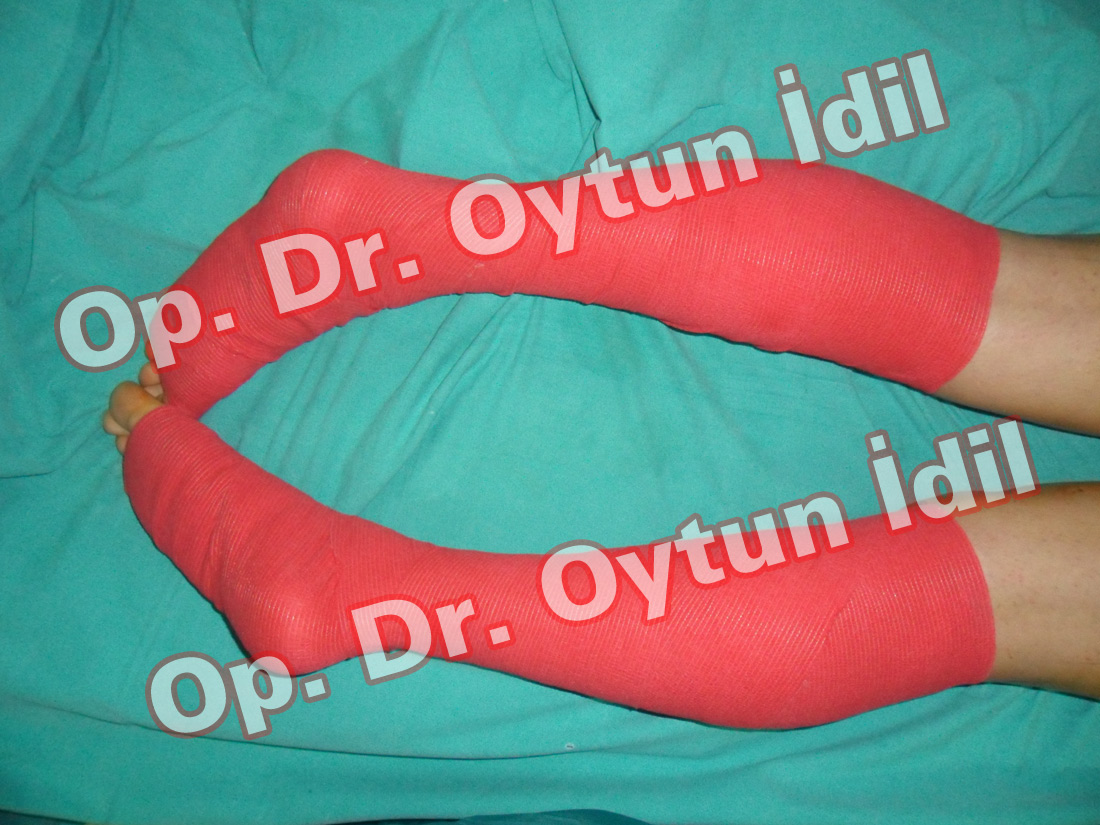
 The morning after the surgery: The pain of the patient, who was hospitalized over night and intravenously administered the analgesics, is worn off. The patient is discharged with the prescription of tablet analgesics and antibiotics. The patient is usually led down to the hospital door with the help of a wheelchair and is discharged home by taxi or by his/her own car. It is okay for patients who do not have an elevator at home to climb the stairs; however climbing the stairs will cause a little pain.
The morning after the surgery: The pain of the patient, who was hospitalized over night and intravenously administered the analgesics, is worn off. The patient is discharged with the prescription of tablet analgesics and antibiotics. The patient is usually led down to the hospital door with the help of a wheelchair and is discharged home by taxi or by his/her own car. It is okay for patients who do not have an elevator at home to climb the stairs; however climbing the stairs will cause a little pain.
 First 3 days at home: The patient is advised to rest at home for the post-op first 3 days. He/She uses antibiotics and analgesics; does not walk apart from going to the toilet but rests. Analgesics are not enough for some patients; in this case, a neuromuscular blocker can also be taken.
First 3 days at home: The patient is advised to rest at home for the post-op first 3 days. He/She uses antibiotics and analgesics; does not walk apart from going to the toilet but rests. Analgesics are not enough for some patients; in this case, a neuromuscular blocker can also be taken.

 Post-op Third Day Follow-up: The patient returns for follow-up on the 3rd or 4th day following the surgery. Usually, we take a video of the patient's gait. Below you will see the gaits of some patients recorded when they return for follow-up on the 3rd day following the surgery. The issue, most frequently questioned by the patients who plan to have this surgery, is how their gait will be affected; so these videos may satisfy your curiosity.
Post-op Third Day Follow-up: The patient returns for follow-up on the 3rd or 4th day following the surgery. Usually, we take a video of the patient's gait. Below you will see the gaits of some patients recorded when they return for follow-up on the 3rd day following the surgery. The issue, most frequently questioned by the patients who plan to have this surgery, is how their gait will be affected; so these videos may satisfy your curiosity.
 In the first follow-up on the post-op 3rd day, the bandages on the leg are removed and are not renewed. I also do not recommend wearing compression/varsity stockings after the operation. This is also frequently asked by the patients. I think it is something recommended abroad, but I personally do not recommend it; I have not heard that this is harmful to patients. I don't think it does any good either. At the utmost, it will prevent swelling in the legs encountered as of the first months, but this is a temporary situation anyway. I do not think it is necessary to constantly wear compression stockings to prevent it. As the patient's bandages are removed after the follow-up and the leg muscle is allowed to relax, the gait improves rapidly and will resume in a few days.
In the first follow-up on the post-op 3rd day, the bandages on the leg are removed and are not renewed. I also do not recommend wearing compression/varsity stockings after the operation. This is also frequently asked by the patients. I think it is something recommended abroad, but I personally do not recommend it; I have not heard that this is harmful to patients. I don't think it does any good either. At the utmost, it will prevent swelling in the legs encountered as of the first months, but this is a temporary situation anyway. I do not think it is necessary to constantly wear compression stockings to prevent it. As the patient's bandages are removed after the follow-up and the leg muscle is allowed to relax, the gait improves rapidly and will resume in a few days.
 The bandages covering the incision line is removed. A spray is applied over the suture line, which will block the contact of the wound with air and the patient is sent home without any further bandages. You can take a shower that night. When you get out of the shower, gently apply compress on the suture line behind the knee with the help of a towel and make sure it is completely dry; it should not stay wet.
The bandages covering the incision line is removed. A spray is applied over the suture line, which will block the contact of the wound with air and the patient is sent home without any further bandages. You can take a shower that night. When you get out of the shower, gently apply compress on the suture line behind the knee with the help of a towel and make sure it is completely dry; it should not stay wet.
 Below you will see the walking videos of some of my patients recorded on different days after surgery.
Below you will see the walking videos of some of my patients recorded on different days after surgery.
![]() Post-Operative 3. Day A patient who had recovered very quickly... To be clear, not every patient regains his normal gait so quickly. This is a very exceptional patient...
Post-Operative 3. Day A patient who had recovered very quickly... To be clear, not every patient regains his normal gait so quickly. This is a very exceptional patient...
![]() If you cannot view the video below, click here to watch it on YouTube.
If you cannot view the video below, click here to watch it on YouTube.
![]() The gait of this patient is very typical for post-operative third day.. The patient, who comes for follow-up on the postoperative 3rd day, still walks with short steps.
The gait of this patient is very typical for post-operative third day.. The patient, who comes for follow-up on the postoperative 3rd day, still walks with short steps.
![]() If you cannot view the video below, click here to watch it on YouTube.
If you cannot view the video below, click here to watch it on YouTube.
![]() The patient at the first post-op follow-up on the third day after surgery...
The patient at the first post-op follow-up on the third day after surgery...
![]() If you cannot view the video below, click here to watch it on YouTube.
If you cannot view the video below, click here to watch it on YouTube.
![]() A patient, who comes for follow-up on the postoperative 3rd day and recovered very quickly... Wedged heeled shoes provide comfort when walking in the first days after surgery.. I suggest patients to wear these kind of shoes for a couple of weeks after surgery to feel themselves comfortable
A patient, who comes for follow-up on the postoperative 3rd day and recovered very quickly... Wedged heeled shoes provide comfort when walking in the first days after surgery.. I suggest patients to wear these kind of shoes for a couple of weeks after surgery to feel themselves comfortable
![]() If you cannot view the video below, click here to watch it on YouTube.
If you cannot view the video below, click here to watch it on YouTube.
![]() A patient, who comes for follow-up on the postoperative fourth day and whose bandages have not been removed
A patient, who comes for follow-up on the postoperative fourth day and whose bandages have not been removed
![]() If you cannot view the video below, click here to watch it on YouTube.
If you cannot view the video below, click here to watch it on YouTube.
 Post-op Sixth Day Follow-up: A female foreign-national patient, who comes for the second follow-up on the postoperative sixth day. After this control, on the same day, we sent my patient abroad by airmail.
Post-op Sixth Day Follow-up: A female foreign-national patient, who comes for the second follow-up on the postoperative sixth day. After this control, on the same day, we sent my patient abroad by airmail.
![]() If you cannot view the video below, click here to watch it on YouTube.
If you cannot view the video below, click here to watch it on YouTube.
![]() Post-op Tenth Day Follow-up: A patient, who had undergone calf restoration surgery, at the follow-up on the postoperative tenth day.
Post-op Tenth Day Follow-up: A patient, who had undergone calf restoration surgery, at the follow-up on the postoperative tenth day.
![]() If you cannot view the video below, click here to watch it on YouTube.
If you cannot view the video below, click here to watch it on YouTube.
![]() Following days... The gait of one patient, recorded during the follow-up, on the post-operative 14th day.
Following days... The gait of one patient, recorded during the follow-up, on the post-operative 14th day.
![]() If you cannot view the video below, click here to watch it on YouTube.
If you cannot view the video below, click here to watch it on YouTube.
 Later days: As you see, it takes 7-10 days for patients who had undergone calf implant surgery to regain their normal gait. Are there further changes observed at the latter days after surgery? Yes. Over the months, the calf muscle as well as the membrane (fascia) surrounding the muscle relaxes a little more and the leg’s diameter increases by another 1-2 centimeters. That means the leg becomes somewhat plumper over time (within a couple of months), For this reason, your surgeon should also take this into account when choosing the right implant. For example, I rather used to prefer 180 cc. implants before. Some of these patients re-applied to our clinic for other plastic surgeries after 6 months-1 year. As I observed, the implant gradually augments the leg over time. Taking into account the latter days after surgery, I don't anymore prefer 180 cc. implants as frequently as I used to. When I use 180 cc. implants for an average case who does not need much augmentation, the image immediately after the surgery is satisfactory; however later (6 months-1 year later) I saw that the legs became plumper than I wanted. I observed that the implants caused the leg to became plumper than I wanted, that’s why I don't anymore use such voluminous implants as I used to.. For an average case, I more often use 110-120 cc implants. I also tell my patients: 'We have to wait 6-9 months to see the final result of this surgery. Please be patient..'
Later days: As you see, it takes 7-10 days for patients who had undergone calf implant surgery to regain their normal gait. Are there further changes observed at the latter days after surgery? Yes. Over the months, the calf muscle as well as the membrane (fascia) surrounding the muscle relaxes a little more and the leg’s diameter increases by another 1-2 centimeters. That means the leg becomes somewhat plumper over time (within a couple of months), For this reason, your surgeon should also take this into account when choosing the right implant. For example, I rather used to prefer 180 cc. implants before. Some of these patients re-applied to our clinic for other plastic surgeries after 6 months-1 year. As I observed, the implant gradually augments the leg over time. Taking into account the latter days after surgery, I don't anymore prefer 180 cc. implants as frequently as I used to. When I use 180 cc. implants for an average case who does not need much augmentation, the image immediately after the surgery is satisfactory; however later (6 months-1 year later) I saw that the legs became plumper than I wanted. I observed that the implants caused the leg to became plumper than I wanted, that’s why I don't anymore use such voluminous implants as I used to.. For an average case, I more often use 110-120 cc implants. I also tell my patients: 'We have to wait 6-9 months to see the final result of this surgery. Please be patient..'
![]() Post-op Third Day Follow-up of a Patient with prior polio: At the first follow-up, these patients walk with difficulty. They usually walk with short short steps, as if they are crawling. It'll take them longer to recover.
Post-op Third Day Follow-up of a Patient with prior polio: At the first follow-up, these patients walk with difficulty. They usually walk with short short steps, as if they are crawling. It'll take them longer to recover.
![]() If you cannot view the video below, click here to watch it on YouTube.
If you cannot view the video below, click here to watch it on YouTube.
![]() Post-op Sixth Day Follow-up of a Patient with prior polio: The recovery of such patients takes longer compared to normal patients.
Post-op Sixth Day Follow-up of a Patient with prior polio: The recovery of such patients takes longer compared to normal patients.
![]() If you cannot view the video below, click here to watch it on YouTube.
If you cannot view the video below, click here to watch it on YouTube.
![]() Post-op seventh Day Follow-up of a Patient with prior polio: Gait of a patient with prior polio on the 7. Day following the first follow-up. Patients who are not subjected to prior polio (who are operated due to knock knees only) almost gain their normal gait on the 7. Day. However, it takes 10-15 days for patients with prior polio to regain their normal gait.
Post-op seventh Day Follow-up of a Patient with prior polio: Gait of a patient with prior polio on the 7. Day following the first follow-up. Patients who are not subjected to prior polio (who are operated due to knock knees only) almost gain their normal gait on the 7. Day. However, it takes 10-15 days for patients with prior polio to regain their normal gait.
![]() If you cannot view the video below, click here to watch it on YouTube.
If you cannot view the video below, click here to watch it on YouTube.

 One of the things that patients are mostly curious about is whether the surgical scars are visible. Surgical scars usually heal very well in this area. There are no obvious scars left, but patients need to be patient. Sometimes it takes 6-9 months for the scars to disappear completely. Below you can see a few examples.
One of the things that patients are mostly curious about is whether the surgical scars are visible. Surgical scars usually heal very well in this area. There are no obvious scars left, but patients need to be patient. Sometimes it takes 6-9 months for the scars to disappear completely. Below you can see a few examples.
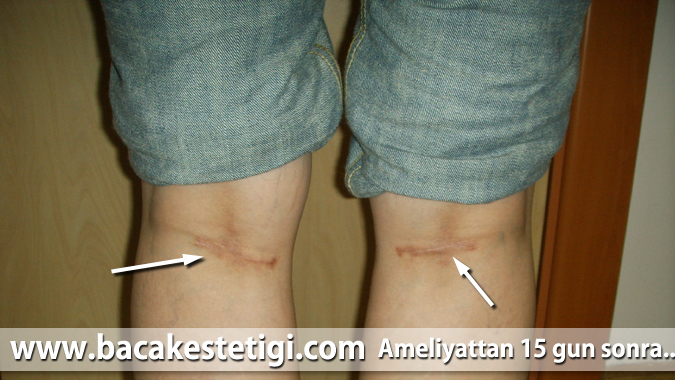
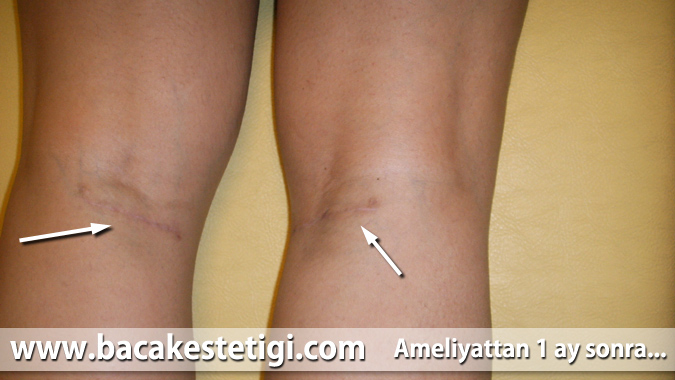
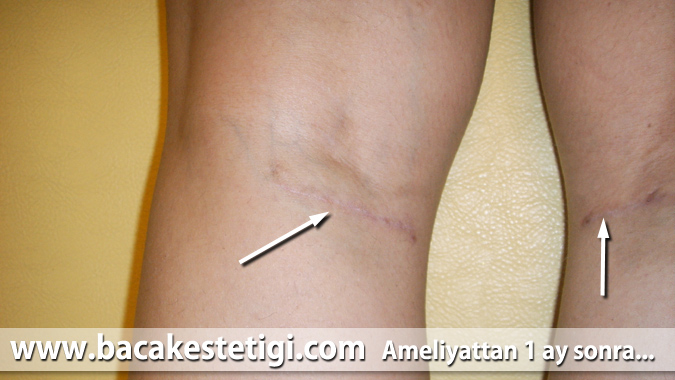
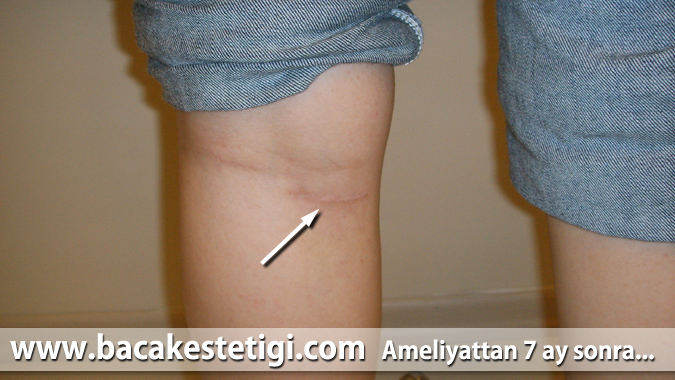
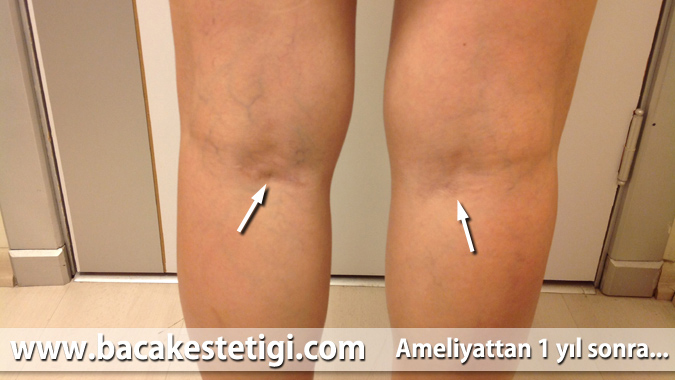
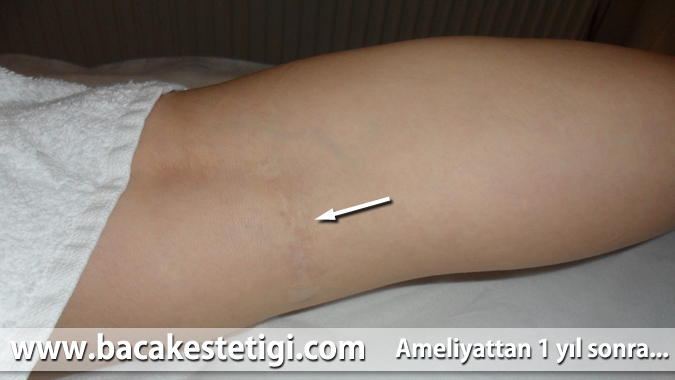
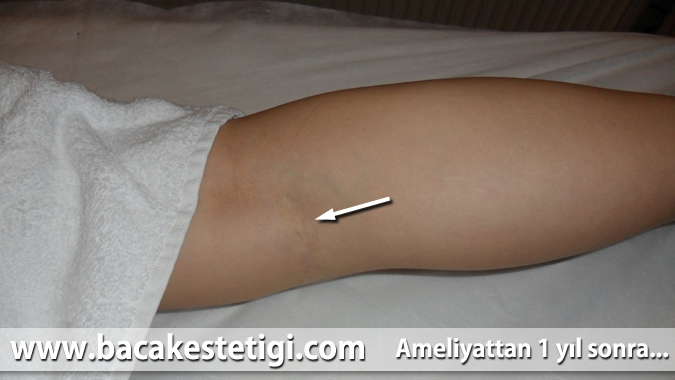
 So far, 3-4 of my patients suffered something like that: 10-15 days after the surgery, they called me and told that they had bruises on their heels and soles of their feet. These bruises indicated a minor muscular hemorrhage. A minor muscular hemorrhage that we probably missed when while inserting the prosthesis during surgery or that occurred later when the patient started walking after the surgery. In 10-15 days, such a minor bleeding descends downwards and becomes visible from outside when it reaches to the sole of the foot and heels. It's a self-healing condition that won't hurt. You do not need to do anything. Bruises completely disappear within 15-20 days.
So far, 3-4 of my patients suffered something like that: 10-15 days after the surgery, they called me and told that they had bruises on their heels and soles of their feet. These bruises indicated a minor muscular hemorrhage. A minor muscular hemorrhage that we probably missed when while inserting the prosthesis during surgery or that occurred later when the patient started walking after the surgery. In 10-15 days, such a minor bleeding descends downwards and becomes visible from outside when it reaches to the sole of the foot and heels. It's a self-healing condition that won't hurt. You do not need to do anything. Bruises completely disappear within 15-20 days.
